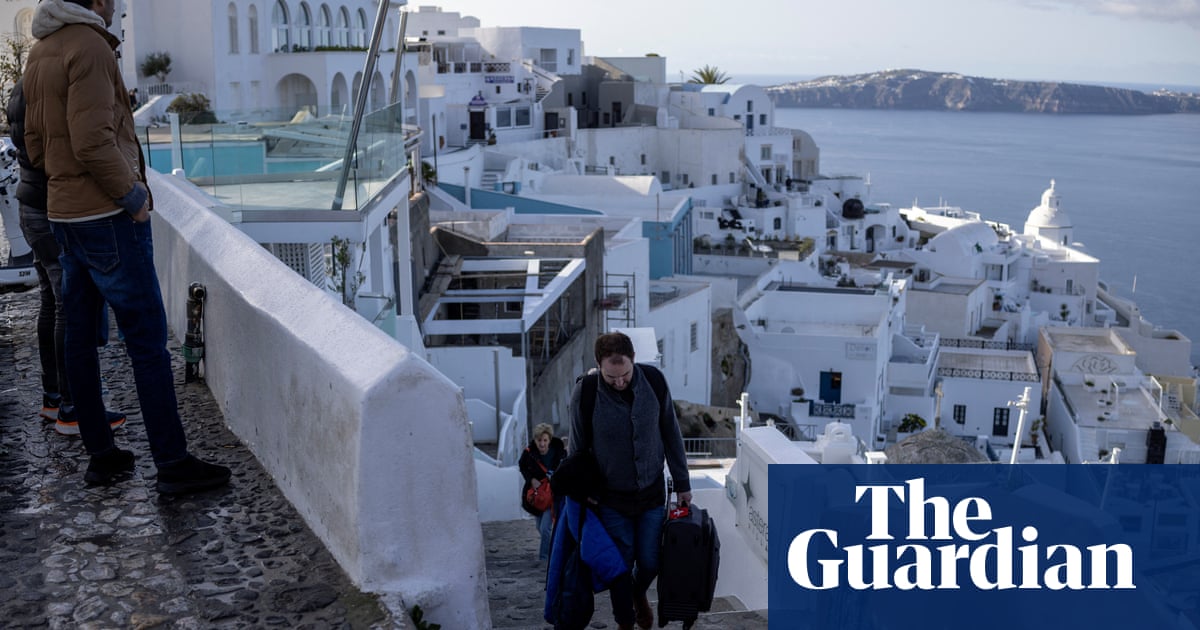On the second day of feeling the ground shake under her feet, Veroniki Balabonidi decided it was to time to leave Santorini. At 4.30am on Sunday she and her two young children were on a ferry bound for the port of Piraeus, surrounded by other families fleeing the Aegean isle.
“It was absolutely packed with residents like us who had had enough of the uncertainty,” she said, speaking from the home of her parents-in-law in Athens.
“Feeling the earth shudder so often is very unsettling, but it wasn’t that so much. Us locals, we’re used to earthquakes. It was the volcano – the fear that it could erupt and start spewing very toxic smoke – that was our real worry.”
By Tuesday about 6,000 people – although some estimates put the exodus at nearly twice that – had followed suit, using any means available: planes, boats and even private yachts and pleasure launches. Aegean, the country’s national carrier, announced that in the space of 48 hours it had flown 2,700 passengers from Santorini to the Greek capital after doubling flights to the island from Monday.
As night fell on a day punctuated by tremors – and at 5.0 magnitude the strongest earthquake yet – the streets and alleys of Fira, the island’s spectacular clifftop town, were eerily empty, shops shuttered, tavernas closed.
Local people had left and so too had most of the foreign workers and tourists visiting out of season. For the first time that anyone could remember, Santorini was in a quiet zone.
“I’ve heard of holidaymakers leaving and asking hoteliers for their money back,” said Artemios Drossos, who has run Grandma’s, an eatery in Fira, for more than two decades.
“It’s easy to understand why. What’s happening is very unnatural, one earthquake after the other in such quick succession, but me personally I’ve got accustomed to them and I’m booked on a flight back there from Athens this weekend. I’ve got things to do and I’m looking forward to it.”
Panagiotis Hatzigeorgiou, a retired police officer and ship worker, echoed that sentiment. “Now we can listen to music alone and have coffee by ourselves,” he told the Associated Press.
A global destination in the chain of Cycladic isles, Santorini is Europe’s most popular island, drawing a record 3.5 million tourists last year. Much of its attraction is down to a beauty born of a volcanic eruption – viewed as the greatest in human history – that occurred 3,500 years ago, leaving the island crescent-shaped, ash-covered and with vast cliffs of lava.
By any measure, the waters around Santorini have been hit by an unusually intense cluster of earthquakes in the past 72 hours. More than 300 undersea tremors have been recorded, many in excess of 4.5 on the Richter scale.
In less than 50 minutes before 8am on Tuesday, when pupils would normally be attending their first class – schools in Santorini and 12 other islands in the Aegean had been shut by the Greek civil protection ministry – seismographs registered six earthquakes, two at magnitudes of 4.8 and 4.9.
If seismologists agree on anything it is that the faultline that produced a devastating 7.7-magnitude earthquake and tsunami in 1956, leaving 53 dead and more than 100 injured, has been “activated” between Santorini and Amorgos, the Cyclades’ easternmost isle.
“Everyone I know has been sleeping outside, in their cars, with one member of the family staying awake all night to keep watch,” Balabonidi said. “I’m 38 and have never experienced anything like it. Everyone is on tenterhooks.”
For natural disaster experts, the big question now is whether the seismic activity is a precursor of a much more powerful earthquake – one that could, perhaps, trigger a tsumani – or even of a volcanic eruption. As the tremors have intensified, rockslides have multiplied. Emergency and rescue teams dispatched to the island have described sonic waves that amount to a near constant rumbling.
Santorini’s volcano last erupted in 1950 and experts say the time is approaching for when it might “let off steam” again.
A second underwater volcano – five miles north-east of Santorini and also active – had caused further alarm because it was closer to the epicentres of the earthquakes.
Greece’s climate crisis and civil protection ministry said last week that monitoring sensors had picked up “mild seismic-volcanic activity” inside the island’s caldera.
“We believe the volcano has small explosions on average every 50 years … so we are within the timeframe [for it to happen],” said Costas Synolakis, an internationally renowned pioneer in the field of natural disasters, ruling out a bigger explosion on the basis that they happen “every 17,000 years”.
He told Skai TV: “We have to watch the volcano very closely. We can’t rule out any scenario.”
Some remained unconcerned. Wataru Saito, 43, an economist who had spent a day on the island, told AFP: “I’m not so worried about the earthquake or volcano, because I came from Tokyo.”
Article by:Source: Helena Smith in Athens












